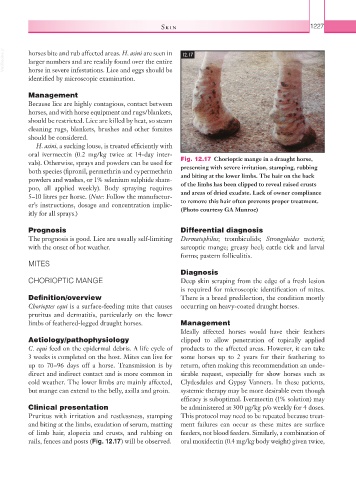Page 1252 - Equine Clinical Medicine, Surgery and Reproduction, 2nd Edition
P. 1252
Skin 1227
VetBooks.ir horses bite and rub affected areas. H. asini are seen in 12.17
larger numbers and are readily found over the entire
horse in severe infestations. Lice and eggs should be
identified by microscopic examination.
Management
Because lice are highly contagious, contact between
horses, and with horse equipment and rugs/blankets,
should be restricted. Lice are killed by heat, so steam
cleaning rugs, blankets, brushes and other fomites
should be considered.
H. asini, a sucking louse, is treated efficiently with
oral ivermectin (0.2 mg/kg twice at 14-day inter-
vals). Otherwise, sprays and powders can be used for Fig. 12.17 Chorioptic mange in a draught horse,
both species (fipronil, permethrin and cypermethrin presenting with severe irritation, stamping, rubbing
powders and washes, or 1% selenium sulphide sham- and biting at the lower limbs. The hair on the back
poo, all applied weekly). Body spraying requires of the limbs has been clipped to reveal raised crusts
5–10 litres per horse. (Note: Follow the manufactur- and areas of dried exudate. Lack of owner compliance
er’s instructions, dosage and concentration implic- to remove this hair often prevents proper treatment.
itly for all sprays.) (Photo courtesy GA Munroe)
Prognosis Differential diagnosis
The prognosis is good. Lice are usually self-limiting Dermatophilus; trombiculids; Strongyloides westerii;
with the onset of hot weather. sarcoptic mange; greasy heel; cattle tick and larval
forms; pastern folliculitis.
MITES
Diagnosis
CHORIOPTIC MANGE Deep skin scraping from the edge of a fresh lesion
is required for microscopic identification of mites.
Definition/overview There is a breed predilection, the condition mostly
Chorioptes equi is a surface-feeding mite that causes occurring on heavy-coated draught horses.
pruritus and dermatitis, particularly on the lower
limbs of feathered-legged draught horses. Management
Ideally affected horses would have their feathers
Aetiology/pathophysiology clipped to allow penetration of topically applied
C. equi feed on the epidermal debris. A life cycle of products to the affected areas. However, it can take
3 weeks is completed on the host. Mites can live for some horses up to 2 years for their feathering to
up to 70–96 days off a horse. Transmission is by return, often making this recommendation an unde-
direct and indirect contact and is more common in sirable request, especially for show horses such as
cold weather. The lower limbs are mainly affected, Clydesdales and Gypsy Vanners. In these patients,
but mange can extend to the belly, axilla and groin. systemic therapy may be more desirable even though
efficacy is suboptimal. Ivermectin (1% solution) may
Clinical presentation be administered at 300 µg/kg p/o weekly for 4 doses.
Pruritus with irritation and restlessness, stamping This protocol may need to be repeated because treat-
and biting at the limbs, exudation of serum, matting ment failures can occur as these mites are surface
of limb hair, alopecia and crusts, and rubbing on feeders, not blood feeders. Similarly, a combination of
rails, fences and posts (Fig. 12.17) will be observed. oral moxidectin (0.4 mg/kg body weight) given twice,

